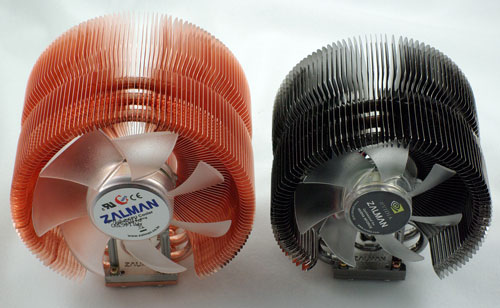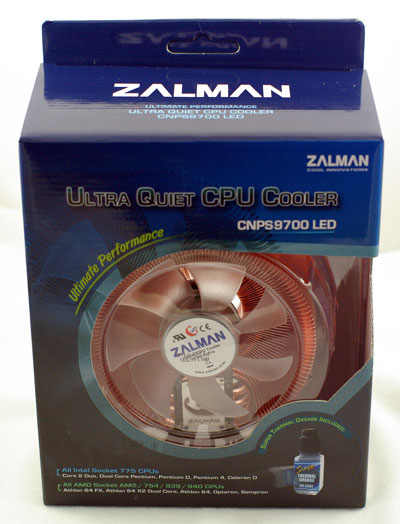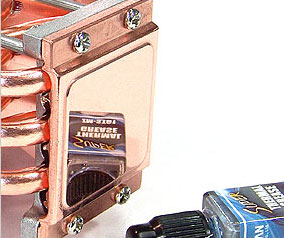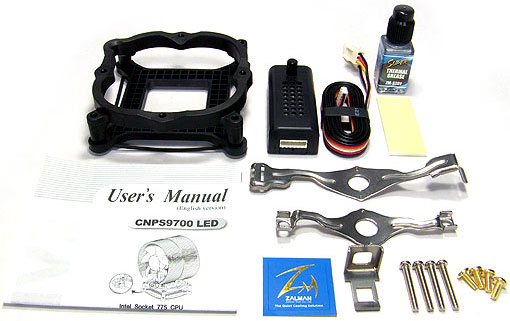The Zalman Twins: 9500 & 9700 Air Tunnels
by Wesley Fink on February 19, 2007 12:40 AM EST- Posted in
- Cases/Cooling/PSUs
Zalman 9700
The Zalman CNPS9700 is basically an oversized 9500, with a larger 110mm fan and a greater surface area of copper fins for cooling.
The size difference is pretty clear in this picture of the 9500 and 9700 side by side. The increase in size and copper also raises the cost. Where the 9500 series sells for around $60, the 9700 retails for about $75.

Packaging for the 9700 is about the same as the 9500. Zalman uses blue for the universal mount and Intel mount coolers, and green to designate AMD coolers. We would like to extend a thank you to Frozen CPU for providing the Zalman CNPS9700 for review.

Few can complain about the polish of the copper mounting surface of the 9700. The 9500 was very similar, with a flat high polish pad that mates to the CPU. Mounting of the 9700 is exactly like the 9500. The same adapters and plates will work on either CPU cooler.

The 9700 includes all the same parts as the 9500 LED plus an AM2 adapter. It also includes the Zalman Fan Mate 2 fan controller. The 9700 can mount Socket 775, AM2, 754, 939, and 940. However, it drops support for Socket 478, which is now three generations back on the Intel tree. Also added is a bottle of Zalman Super Thermal Grease.
Zalman Super Thermal Grease
Included in the CSN9700 kit is a bottle of Zalman Super Thermal Grease with a brush in the cap to make application easier.
| Zalman Super Thermal Grease Specifications | |
| Type | Non-curing compound |
| Capacity | 3.5g |
| Specific Gravity | 2.42 |
| Temperature Stability | -40C-150C (-40F-302F) |
Specifications
Our test system is Intel Socket 775, but the Zalman CNPS9700 LED will mount on all current CPU sockets. All the needed hardware is included to fit the variety of supported sockets.
| Zalman CNPS9700 LED Specifications | |
| Heatsink | |
| Dimensions | 90(L) X 124(W) X 142(H) mm |
| Weight | Heatsink: 690g, Total (including fan): 764g |
| Base Material | Pure Copper and Aluminum |
| Dissipation Area | 5,490 cm2 |
| Fan | |
| Fan Size/Weight | 110 mm, 74g |
| Bearing Type | 2 Ball-Bearing |
| Speed - Silent Mode | 1,250RPM +/- 10% |
| Speed - Normal Mode | 2,800RPM +/- 10% |
| Noise Level - Silent Mode | 19.5dB +/- 10% |
| Noise Level - Normal Mode | 35dB +/- 10% |
The main difference between the Zalman 9700 and the 9500 is size and weight. The 9700 is 142mm tall compared to the 9500 height of 125mm. This 17mm height difference will matter to some with smaller cases, but neither of these two Zalman coolers is truly small. They are generally not suitable for small, flat Media PC cases or modular cases designed for rack mounting.
The 9700 also weighs 764g, compared to the 530g of the 9500. While the motherboard mounting method may handle the 530g weight just fine, you should be careful with the heavier 9700. At almost two pounds this is a heavy heatsink and the plastic mounting plates allow flex - they are not rigid like some of the metal plates used on competing large CPU coolers. It is probably not a good idea to use the 9700 on a PC that will be moved frequently, such as a LAN Party PC. Carrying around a mounted heavy cooler like the Zalman 9700 could be asking for trouble.










50 Comments
View All Comments
Avalon - Monday, February 19, 2007 - link
Keep up the good work. I'm enjoying watching the list of coolers you guys review grow and grow, and I think it's great that you'll be doing the Scythe Infinity and Ninja soon. I know I've mentioned this before, but I still want to see the Coolermaster Hyper TX if you guys can get your hands on one. Reason being is it looks as though it provides excellent PWM area cooling...which brings me to my next question...Have you guys considered throwing in PWM area temperatures? Some coolers are great at cooling the CPU, but awful at providing air anywhere else...and PWM cooling can help with stability.
Wesley Fink - Monday, February 19, 2007 - link
We agree that PWM is an important consideration, and it is something we will likely visit in a future article. Most of the top motherboards these days use passive sinks on the power transisitors and northbridges, but they also come with cooling fans for use with water cooling and HSFs that do not provide good cooling for board components. The 680i has such a fan and we use it in our testing to try to remove the variable PWM air flow and temps as a performance factor. Of course, that avoids the question by removing the variable, rather than answering it. We will try to address this in some future article, but for now we have a lot more coolers waiting for tests on our standard test bed.acivick - Monday, February 19, 2007 - link
I didn't see it listed anywhere in the review, but I'm assuming that the included thermal compound was used, at least for the 9500/9700. If the same compound was not used for all coolers, they should be retested, as it's not a valid test. Using the same compound on each would make it more of an even playing field and would thus be testing the performance of the cooler only.For instance, MX-1 is supposed to be much better than the stuff Zalman provided, giving a 3-5C decrease in overall temperatures.
Wesley Fink - Monday, February 19, 2007 - link
We use the thermal compound that comes with the cooler in most cases. If it is just a little packet of cheap thermal compound we use our standard, which is a silver colored tube thermal compound of pretty decent performance - not something exotic like MX-1.In the case of the Zalman 9500 and 9700 we used the Zalman Thermal Grease. Before replying to this question I tested the Tuniq Tower 120 with the Zalman Thermal Grease. Results were all but identical to the tests we ran using our bulk silver colored compound.
Over the years I've used many thermal compounds, and if you use a quality product and apply it properly the results have been similar. I hear what you are saying about a 3-5C difference with MX-1, but I certainly have not seen those kinds of gains with any thermal grease. I can also point you to a serious review that shows toothpaste and Vegemite with superior performance to Arctic Silver 5. At some point in the future we might take a closer look at the impact of thermal compounds on performance, but for now I am confident our current test methods are not introducing new variables with sloppy choices of thermal compound. We are prudent in our choices, but not maniacal.
JarredWalton - Monday, February 19, 2007 - link
Except a lot of people use whatever comes with the HSF. Wes would have to explain what thermal compound he's using, but I would assume he's sticking with the included stuff for each HSF where possible. If nothing is included... well, I don't know what he does there. :) Basically, though, I don't think retesting is in order unless he's using high-grade stuff on HSFs that omit the inclusion of a compound.VooDooAddict - Monday, February 19, 2007 - link
I agree that he should make it clear though what he's using.Using the shipped compound with these units would be preferable from complete product a review standpoint. As it stands there's no mention of his cleaning and reapplying new compound either. From a simplicity standpoint of reviewing and a better comparison of coolers, it would be easier to just use one compound for all the coolers to reduce cleaning time and variables.
ozzimark - Monday, February 19, 2007 - link
umm, my 9500 looks NOTHING like that base :-Xhttp://www.eclipseoc.com/image/cooling/zalman%20cn...">click for pic!
dev0lution - Monday, February 19, 2007 - link
Good info. I was leaning towards getting the 9500 since I don't think my 7700-alCu will fit on the eVga 680i board I haven't got around to installing. I might consider getting one of the alternatives now, seeing as how it doesn't look like the zalman's are worth the price premium.Fishie - Monday, February 19, 2007 - link
The Tuniq is 54dBs while the 9700 is 57dBs. Twice as loud? Wouldn't twice as loud be 108dBs? Not to mention the 9700 is quieter than the Tuniq at 24" away.
Wesley Fink - Monday, February 19, 2007 - link
3db is twice the sound energy, since the db scale is logarithmic. At one time twice the energy was considered twice as loud, but recent research shows 6db to 10db increase to be perceived by the human ear as twice as loud - depending on whose study you read. I have stated this in past reviews. To be more precise I changed the wording in the review to twice the sound energy.